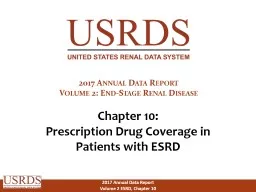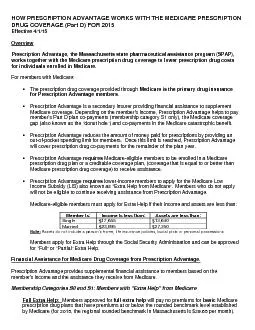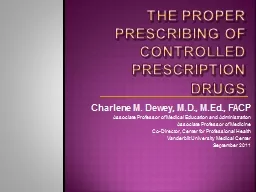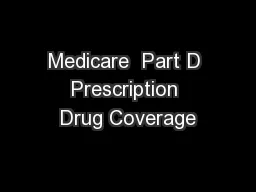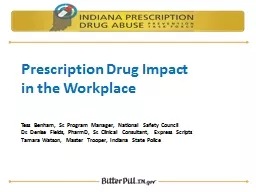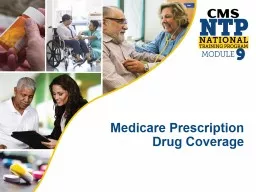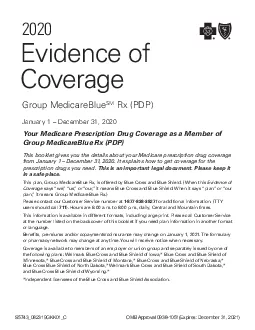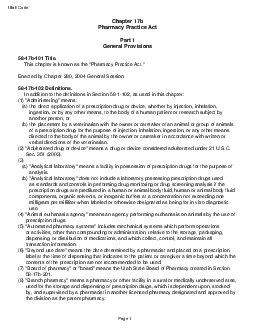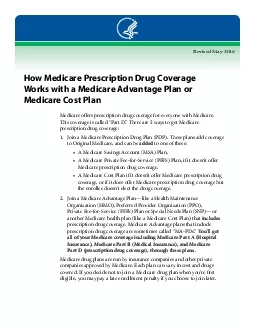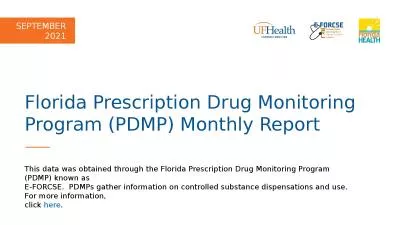PPT-Chapter 10: Prescription Drug Coverage in
Author : mitsue-stanley | Published Date : 2020-01-23
Chapter 10 Prescription Drug Coverage in Patients with ESRD 2017 Annual Data Report Volume 2 EndStage Renal Disease 2 vol 2 Figure 101 Sources of prescription drug
Presentation Embed Code
Download Presentation
Download Presentation The PPT/PDF document "Chapter 10: Prescription Drug Coverage i..." is the property of its rightful owner. Permission is granted to download and print the materials on this website for personal, non-commercial use only, and to display it on your personal computer provided you do not modify the materials and that you retain all copyright notices contained in the materials. By downloading content from our website, you accept the terms of this agreement.
Chapter 10: Prescription Drug Coverage in: Transcript
Chapter 10 Prescription Drug Coverage in Patients with ESRD 2017 Annual Data Report Volume 2 EndStage Renal Disease 2 vol 2 Figure 101 Sources of prescription drug coverage in Medicare ESRD enrollees by population 2015. Some people with limited resources and income also may be able to get Extra Help to pay for the costsmonthly premiums annual deductibles and prescription copaymentsrelated to a Medicare prescription drug plan The Extra Help is estimated to be worth For members with Medicare The prescription drug coverage provided through Medicare is the primary drug insurance for Prescription Advantage members Prescription Advantage is a secondary insure r providing financial assistance to supplement Medicare …an invisible epidemic. MPH 500. By Cyrina Allen. February . 24, 2014. Prescription Drug Abuse. Currently in the United States, is the fastest growing problem(Centers for Disease Control and Prevention [CDC], 2012). Charlene M. Dewey, M.D., M.Ed., FACP. Associate Professor of Medical Education and Administration. Associate Professor of Medicine. Co-Director, Center for Professional Health. Vanderbilt University Medical Center. 1. October 2017. What’s Medicare Prescription . Drug . Coverage . (Part . D)?. Medicare drug plans . Approved by Medicare. Run by private companies. Available to everyone with Medicare. Uniform coverage minimum. in . the Workplace. Tess Benham, Sr. Program Manager, National Safety Council. Dr. Denise Fields, . PharmD. , Sr. Clinical Consultant, Express Scripts. Tamara Watson, Master Trooper, Indiana State Police. Gil Kerlikowske, . Director. White House Office of National Drug Control Policy. 2. ONDCP’s Authority. Established by the Anti-Drug Abuse Act of 1988. Principal purpose: Establish policies, priorities, and objectives for the nation's drug control program. Coverage. SHIBA and WA Version. Updated August 2018. Content. Lesson 1. —The Basics................................................................. Lesson 2. —Medicare Part D Benefits and Costs......................... Learning Objectives. Participants will be able to:. Associate the history of prescription drug use in America with the current trend of prescription drug abuse;. Differentiate between the three most commonly abused types of prescription drugs;. Bob Twillman, Ph.D., . FAPM. Executive . Director. American . Academy of Pain . Management. Chair, Advisory Committee. Kansas Prescription Drug Monitoring Program (K-TRACS). Prescription Drug Abuse is a . x/MCIxD 0 x/MCIxD 0 Group MedicareBlue30Rx Customer Service -877-838-3827Calls to this number are free 800 am to 800 pm daily Central and Mountain timesVoicemail available after hoursCustomer Utah CodePage 11 Administering meansa the direct application of a prescription drug or device whether by injection inhalationingestion or by any other means to the body of a human patient or research Works with a Medicare Advantage Plan or Medicare Cost PlanRevised May 2018Medicare o31ers prescription drug coverage for everyone with Medicare prescription drug coverage 1Join a Medicare Prescription This data was obtained through the Florida Prescription Drug Monitoring Program (PDMP) known as . E-FORCSE. . PDMPs gather information on controlled substance dispensations and use. For more information, .
Download Document
Here is the link to download the presentation.
"Chapter 10: Prescription Drug Coverage in"The content belongs to its owner. You may download and print it for personal use, without modification, and keep all copyright notices. By downloading, you agree to these terms.
Related Documents

